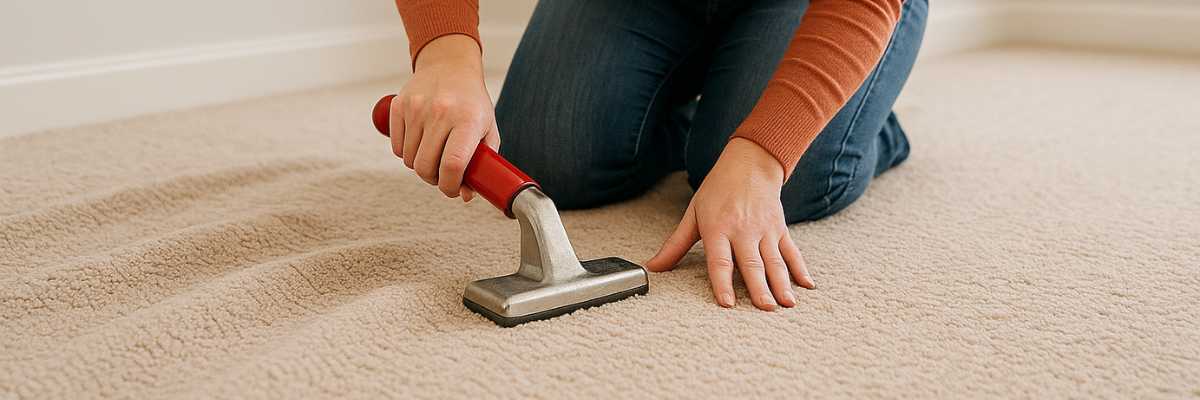Get free quotes within minutes
How to Fix Pet Damage on Carpets

Table Of Content
- Introduction
- Types of Pet Damage on Carpets
- Ways of Eliminating Pet Urine Stains and Smell
- How To Remove Pet Hair And Dander Off Carpets?
- How to Repair Carpet Tears and Scratches?
- How to Fix Chewing or Digging Damage?
- How to Manage Excessive Moisture or Spills?
- Preventing Future Pet Damage On Carpet
- Conclusion
Pets are an endearing part of many Australian families, companions, friends and sources of happiness and comfort. But that is not the end of the problems associated with living with pets, either in their disposition or behaviour. Pet damages on the carpets include urine stains, scratch marks, and any other damage caused by the pet’s teeth, or claws and paws. Luckily, if you apply the correct method and products, you will be able to repair your carpets to their best and maintain your carpet standards.
This comprehensive blog will help pet owners in Australia to identify and repair various types of pet damage to carpets; cleaning solutions for stains, mend solutions for tears and pet odour control techniques. We will also discuss how to avoid such problems in the future and how to keep the house clean if you have pets.
Types of Pet Damage on Carpets
It is necessary to note that particular types of damage can be caused by pets to carpets before divulging helpful information on repairing the damages. The most common types of damage include:
- Pet Urine Stains and Odours: A common problem that won’t go away easily is pet urine. In addition to producing distinct stains, urine consistently introduces hard-to-eradicate smells on your carpets. Urine stains are very difficult to remove because the liquid soaks right into the carpet fibres and can even seep through to the underlay.
- Pet Hair and Dander: Carpets may become easily worn out by pet hair if you own long-haired creatures in your home. Hair tends to settle deep into the carpet strands, meaning that vacuum cleaners cannot pick them up fully. Also, the pet dander is an instigator of allergies, and it makes the carpet feel dirty.
- Tears and Scratches: Cat and dog claws are certain to rip and snag carpets and this is inclusive of other indoor pets. Dogs will gum or paw at the carpets whereas cats will claw at the same and rip it apart. Such tears and frays may enlarge after some months or years making them become a source of blight.
- Chewing or Digging: Any pet that chews on furniture and carpets will be easily identifiable by the signs left behind, such as holes or bare spots. This is especially true for younger dogs, especially puppies that tend to chew on things when teething, or anxious or bored cats or dogs.
- Excessive Moisture or Spills: It was all over, not only was ‘accidents aren’t always about urine, but ‘accidents aren’t always about weapons’. Harsh elements such as drinks, and slobber come from pets that drool or those pets that groom their mouth with their tongue, which if not wiped out very quickly causes the formation of wet patches which triggers discolouration of carpets and the formation of mildews.
How to Repair Pet Damage on Carpets?
Ways of Eliminating Pet Urine Stains and Smell
Pet urine spots are probably some of the worst enemies when it comes to cleaning as they harden when they dry and become even harder to remove if left for quite some time. As with any spill, they are easier to deal with if you act fast to control the clotting process. Here’s how to remove pet urine stains and odours effectively:
- Step 1: Blot the Stain: Immediately one identifies the urine stain on the carpet, they should use a clean dry cloth to wipe off the stain as many times as possible. Never scrub the stain as this will actually make it worse by pushing the urine down into the carpet fibre.
- Step 2: Wipe the Area with a Vinegar Solution: Take an equal proportion of white vinegar and water and add the mixture to a spray bottle. Vinegar severs the ability of ammonia in urine to produce the smell. The solution should be applied to the affected part and allowed to work for several minutes.
- Step 3: Use a Baking Soda Paste: It is preferable to apply baking soda on other parts of the carpet that are moist and produce a smell. It can be washed with shampoo or you can also make a paste from baking soda and some water and apply it on the stain. Allow the smoke to settle on the carpets for at least 15 to 20 minutes then using a vacuum cleaner gather the remaining smoke that has fallen off the carpets.
- Step 4: Use a Commercial Pet Odour Remover: If the stain remains, you might apply a product for the pet smell or use some enzyme solution for cleaning. These products decompose the proteins present in pet urine and erase the stain as well as the odour. As it is advised on the label, let the cleaner dry on its own.
- Step 5: Take Professional Carpet Cleaning If the urine has penetrated the carpet piles and or the smell appears to be persistent it may be wise to bring in a professional carpet cleaning company. Most professional cleaners have the relevant tools to remove strong urine and smell that has settled deep in the carpet.
How To Remove Pet Hair And Dander Off Carpets?
Pet hair can easily build up on a carpet floor, particularly, if your pet tends to shed lots of hair. It is impossible to get rid of pet hair completely but it is possible to reduce the amount that gathers frequently through cleaning. Here's how to remove pet hair from carpets:
- Step 1: Use a Vacuum with a HEPA filter: Equate your cash on a machine that has a HEPA (High-Efficiency Particulate Air) filter and a pet hair tool. Many of these vacuums are specifically built to be able to deal with pet hair and dander. It’s important to vacuum the floor in every corner and along edges since hair tends to linger there.
- Step 2: Use a Rubber Broom or Carpet Rake A rubber broom or a carpet rake can be really useful to ‘comb’ the pet hair right out of the carpet pile. You only need to take the broom and glide over the carpet several times in a short range, the hair will accumulate at the corner.
- Step 3: Try a Lint Roller For small areas or for the pet hair that has not been cleared by vacuuming use the lint roller to remove the hair. Status; Lint rollers can be useful when it comes to removing hair from places like the underside of furniture, or around corners.
- Step 4: Bath and Groom Your Pet Regularly In order to minimize the shedding of fur, guarantee your pet is groomed as required. Frequently combing the pet’s coat also aids in the fact that less hair is shed and consequently tends to get stuck on carpets.
How to Repair Carpet Tears and Scratches?
Paws with claws are very dangerous to the carpet, they are likely to tear the carpet or fray it up. If the wound is slight, then it is possible to make it yourself. Here’s how:
- Step 1: Trim Loose Fibres With a scissor, you should then cut all hairs and other friable material around the damaged area. Try to avoid trimming the surrounding carpet too short because this will only aggravate the problem.
- Step 2: Use Carpet Repair Tape Carpet repair tape is the most recommended tool for fixing small holes or small damages in the carpet. Take a length of tape and trim it to fit the size of the tear then stick it underneath the carpet. Afterwards, working in one direction, press down the edges of the carpet onto the tape in order to fix the fibres.
- Step 3: Patch the Carpet For larger tears, one must patch the carpet so that there will be no way that one would not know that the carpet has been repaired. You can purchase a remnant of carpet in the same colour and texture as the main area or you cut a piece of carpet from under a couch, etc. Affix adhesive to the area around the patch and then lay the patch on it.
- Step 4: Deal with Professionals For Bigger Repairs: If the tear is going to be too big for patching or you are not confident with the repair work that you are carrying out you should seek the assistance of a professional. It is possible to bring the qualifying specialist, who will be able to repair the wound and return the carpet to its normal form.
How to Fix Chewing or Digging Damage?
Chewing is seen in puppies or young animals, but even older pets can be destructive chewers and diggers at times. Here’s how to deal with these problems:
- Step 1: Remove the Source of Chewing There are other instances for example when your pet is chewing on your carpet to ensure that this behaviour is altered. It helps to offer them chew toys or other objects which could help to entertain them and prevent them from chewing on the carpet. Poisons that dogs will not eat but will sniff and lick include bitter-tasting sprays meant for pets to discourage chewing.
- Step 2: Patch the Damaged Area For minor chew spots here are some suggestions: You will be able to repair small chewing marks by patching the carpet as explained above. For a very big and deeper hold in the carpet, you will have to remove some part of the carpeting.
- Step 3: Consider Carpet Protectors If you realise that your pet often digs or chews in particular places, you should use carpet protectors or mats there.
How to Manage Excessive Moisture or Spills?
Not only will the owner spend a lot more money on cleaning and possibly replacing the carpet, but drool or water left on the carpet can cause it to change colours and attract mould. Here's how to tackle the problem:
- Step 1: Dry the Area Immediately In cases of spilling a mixture containing moisture wipe the area with an absorbent material such as cloth. Fan or blow-dry the area on cool to dry quickly to avoid injury from the hot water.
- Step 2: Use a Cleaning Solution If it has some discolouration due to the moisture, wash the area with a solution of vinegar and water or a store-bought carpet cleaner. Always rinse the area well with clean water to ensure no residue is left behind on the skin.
- Step 3: Check for Mould or Mildew In case the area has long been in contact with water or moisture then look for the presence of mold or mildew. Should you notice any signs of mould, you will have no option but to get a professional to help you clean it properly and treat the carpet appropriately.
Preventing Future Pet Damage On Carpet
While it’s impossible to eliminate the risk of carpet damage when you have pets, there are several ways to reduce the likelihood of it happening in the future:
- Train Your Pet Entraining the pet prevents damage; it is advisable to train your pet to keep off some areas in the house or stop biting furniture.
- Regular Cleaning When carrying out routine and accidental clean-ups it makes it easier to maintain carpet free from damage.
- Use Pet-Friendly Furniture Covers It can save both furniture and carpets from being scratched, or bitten by pet claws, and also from accidental incidents such as vomiting or soiling.
- Provide a Designated Pet Area Having rugs or mats put in place means that more valuable carpets are out of reach for a pet hence preventing it from destroying them.
Conclusion
When your pet causes carpet damage, it may be quite irritating especially if it occurs frequently but fortunately, most of the damages can be fixed easily. It can be eradicating pet stains, fixing damages caused by animals or preventing damages in the future. By following this guide on pet damage carpet repair, you can enjoy a clean, fresh, and pet-friendly home without compromising on comfort or cleanliness. If the damage done is beyond your capability to repair, do not be afraid to consult professional carpet cleaners/repair people or your landlord. With a little effort, you’ll get your carpets back in shape so that your home looks nice and welcoming for you and your pets.
YOU MIGHT ALSO BE INTERESTED IN

Carpet Rippling: Common Causes, How to Prevent It, and the Best Fixes
Capital Cities
- Carpet Repair Services Services in Melbourne
- Carpet Repair Services Services in Brisbane
- Carpet Repair Services Services in Sydney
- Carpet Repair Services Services in Adelaide
- Carpet Repair Services Services in Perth
- Carpet Repair Services Services in Canberra
- Carpet Repair Services Services in Hobart
- Carpet Repair Services Services in Darwin












